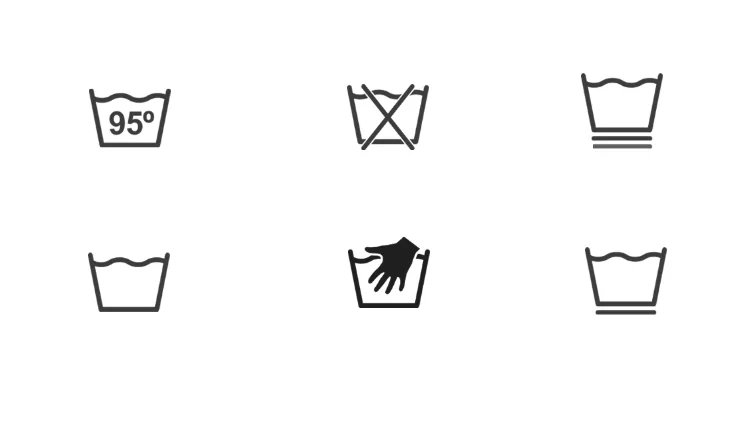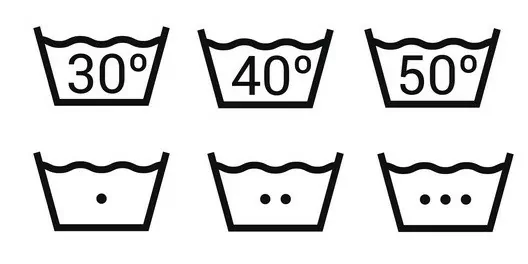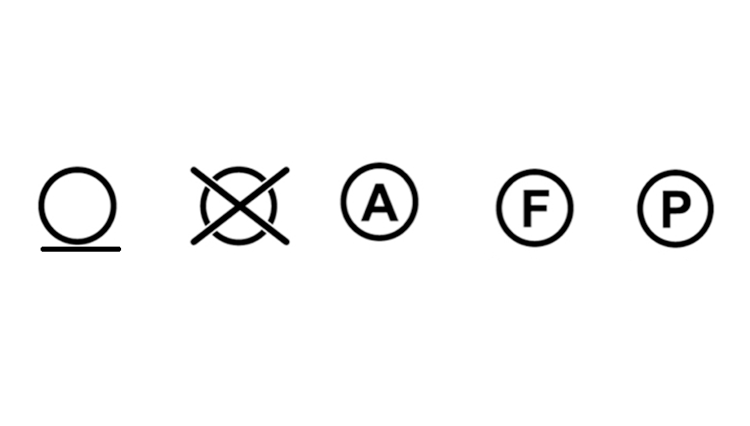Summary:
- The textile symbols bring information about the care that customers should have with their garments;
- Attached to the labels, these symbols indicate how the clothes can last longer;
- Audaces helps your company to identify the best textile symbology for each item in the collection. Get Audaces360’s free trial and find out how!

Consumers are often unaware of textile symbols, and many times, their meaning can go unnoticed.
Found on clothing labels, these symbols inform the correct way to wash, iron, and dry garments. The instructions show how to take care of the pieces so that they last longer.
Each of the icons or images carries specific guidance on the conservation of the pieces. Therefore, it’s important that clothing manufacturers produce labels that do not easily detach from clothes – and that consumers pay attention to what they indicate.
Want to comprehend all details of textile symbols and how they work?
Sumário
We will tell you everything below!
What are textile symbols?
When a product is marketed, it must provide all relevant data on features, quantity, components, quality, and cost, in addition to informing possible risks associated with the raw material.
Similarly, it would not be different with the pieces of fashion companies. Every textile product manufactured domestically or imported must be labeled by the manufacturer or importer.
Therefore, the textile symbology is a set of pictures that make up the clothing tag. They are used to describe the necessary instructions on how to care for and maintain the items purchased by the end user.
Learn more: Why consider sustainable consumption and production for your company?
What is the textile labeling regulation?
The requirements for labeling textiles vary from country to country.
For instance, in the United States, textile and apparel products must be labeled with fiber content, the manufacturer or dealer identity, and the care instructions.
On the other hand, in the Europe Union (EU), Regulation (EU) No 1007/2001 states that textile labels should include either mandatory or voluntary information such as the country of origin and size.
Textile Labelling in the United Kingdom has a unique stipulation regarding textile flammability for nightwear: a “KEEP AWAY FROM FIRE” warning must be printed in red block capitals, as outlined in this article.
English is the language of choice for labeling in India, and the Legal Metrology (Packaged Commodities) Act mandates that garments and hosiery must be labeled with the name, description, size, full address, and customer care number of the manufacturer.
The Act also requires garment sizes to be presented in centimeters.
Providing this data correctly is a fashion manufacturing duty with the customers.
Thus, they will be able to make proper use of the pieces, prolonging the useful life of the product and increasing trust in the brand.
Learn more: 4 top tips for a successful fashion collection launch
What are the rules for textile symbols?

In 1975, the International Association for Textile Care Labeling (Ginetex) developed a standardized set of textile symbols to simplify the labeling of yarn and clothing products.
Universal care symbols are used to reduce language on labels. These symbols provide instructions on how to best care for the items.
There are five basic categories of symbols:
- Washing: a trapezoid-shaped tub with squiggly lines representing water
- Bleaching: a triangle
- Drying: a square
- Ironing: an iron
- Professional Textile Care: a circle
The use of these symbols is now mandatory around the world.
Learn more: How does technology in fashion impact the textile industry?
Textile symbols and their meanings
As said before, each of the icons printed on the labels has a specific meaning within the textile symbology.
Clothing companies must be well-versed in these symbols and their respective instructions to effectively communicate them to the final consumer.
Let’s take a closer look at the main images displayed on the labels and what they represent:
Washing

The water basin icon serves as a symbol for laundering clothes after they have been purchased by the consumer. This indicates the proper home washing procedure and the maximum temperature at which the garment can be washed.
Bleaching

The triangle icon brings information about care for the conservation of textile articles, referring to the use of bleach.
When the triangle is empty, it means that the product can receive any type of bleaching. If it contains diagonal lines, it signifies that the use of chlorinated bleach is not allowed.
If the triangle features a diagonal cross, no bleach should be used.
Drying

There are two symbols used for drying:
Drum drying
Drum drying (or post-wash drying) is represented by a circular symbol within a square icon.
A single dot indicates that the article should be dried using low heat, while two dots imply normal temperature drying.
Natural drying
Natural drying is denoted by a square with inner lines.
When the box has two vertical lines, the garment should be dried on a drip line.
A single vertical stroke implies drip-free drying.
Horizontal lines stand for either drip drying (if there are two lines) or drip-free (with one line).
Ironing

The iron icon symbolizes the task of ironing garments at home with either a dry or steam iron.
The representation of one, two, or three dots inside the icon indicates the highest temperature allowed.
Professional cleaning

The circle refers to professionally performed dry or wet cleaning.
Caution: If the circle is overlaid with an “X”, then dry-cleaning should not be done.
What is the mandatory information on clothing labels?
The labels must contain specific mandatory details to help consumers use and conserve their garments in the best way, guaranteeing a sustained level of quality.
Thus, these details should answer any questions customers may have, such as the type of washing, and the composition material, among others.
Mandatory information must be clearly and permanently visible, not prone to fading, coming loose, dissolving, or easily removing, and remain with the product for its entire lifespan.
The mandatory information is:
1) Required information
- Name or business name of the manufacturer or importer;
- Country of origin;
- Composition of fibers or filaments;
- Conservation treatments and care;
- Textile symbols;
- Size or measurements identification.
2) Country of origin
One of the requirements is for the name of the country of origin to be in the language of the country of consumption. Some companies only include the flag or the economic bloc, but this is not enough to comply with the regulations.
3) Textile composition
The names of the textile compositions must be correct and follow the technical regulation. Therefore, never use your non-textile trademarks or names on your garment label!
The best way to provide the information is to list the fiber or filament name followed by the percentage of each in descending order.
If the textile composition used is hard to identify, you can state “COMPOSITION NOT DETERMINED” or “MISCELLANEOUS FIBERS” on the label.
In pieces composed of two or more different parts, it will be necessary to indicate the composition of fibers in each of them.
4 ) Treatment and conservation care
The information necessary for and maintenance of clothing are the following textile symbols, that should be applied in this order:
The textile symbology must follow this same order:
- Washing;
- Beaching;
- Drying;
- Ironing;
- Professional cleaning.
5) Sizes and dimensions
To indicate the sizes of garments, the pattern used should be:
- S: Small;
- M: Medium;
- G: Large;
- XL: Extra Large.
In addition to the letter sizes, in many countries, there are also numeric measurements, which are always in pairs of two. Common measurements include:
- 34;
- 36;
- 38;
- 40;
- 42;
- 44.
Apply textile symbols to your fashion collection with Audaces

For those who wish to remain to stay up to date with the regulations and rely on technology to increase sales of their garments, Audaces offers innovative solutions that unite all stages of the process, from design to production.
Audaces is the ideal choice to achieve the highest performance for your fashion business. Here’s how:
Audaces360
Audaces360 is an all-inclusive multi-solution that helps you overcome the main challenges in the fashion industry, leading to successful outcomes from the beginning of the collections.
Audaces has developed the ideal technology to generate greater convenience, time efficiency, and agility in your company’s deliveries!
Conclusion
In conclusion, fashion products must be made with a label that is difficult to remove and displays the most important information regarding the item. They range from the size of the model to the textile symbols, with instructions on cleaning, washing, and other care needed for conservation.
These recommendations are of great value to the end customers, as it allows them to extend the lifespan of the items, thus promoting sustainable consumption.
Technology helps your company integrate the right textile symbols with each piece in your fashion collection.
To learn more fabric types and how to properly classify them, download our e-book for free:
FAQ
Textile symbols are the icons found on clothing labels, used to provide instructions on how to properly wash, iron, and dry the garment.
Clothing tags must include the name or corporate name of the company, country of origin, the composition of materials, treatments, and care instructions for conservation and identification of size or dimensions
In 1975, the International Association for Textile Care Labeling (Ginetex) developed a standardized set of textile symbols to simplify the labeling of yarn and clothing products.










